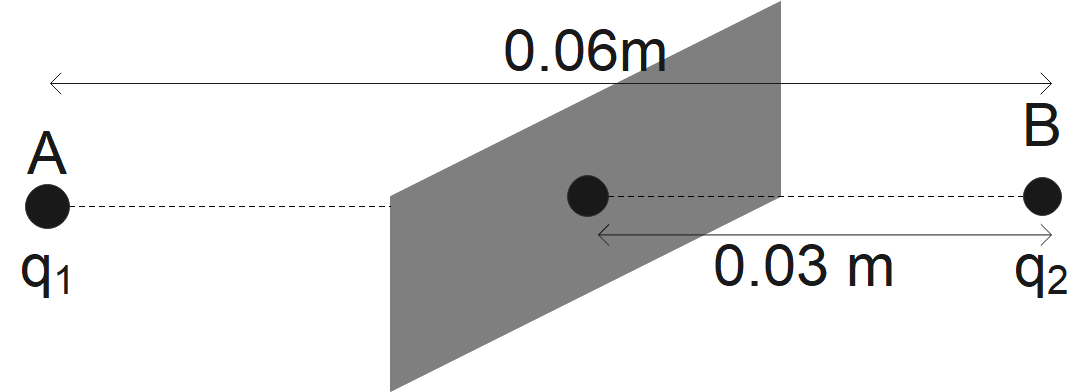
Two charges 2μC and −2μC are placed at points A and B 6 cm apart.
(a) Identify an equipotential surface of the system.
(b) What is the direction of the electric field at every point on this surface?
Answer
528.3k+ views
Hint: Since there are two charges given and both the charges are opposite in nature, this means that the equipotential surface will have the zero potential as both charges are different, they will cancel out the influence of each other. If they are the same charges then the equipotential surface will be the point where the influence from both of them is the same.
Complete step by step solution:
We have been given that
${{q}_{1}}=2\mu C=2\times {{10}^{-6}}C$
${{q}_{2}}=-2\mu C=-2\times {{10}^{-6}}C$
Distance (r) = 0.06 m
A.) In the first part we need to find the equipotential surface, which means that the potential will be zero at that point due to both the charges
Let “x” be the point in between both the charges where potential is zero
Therefore, by using formula
$\dfrac{1}{4\pi {{\varepsilon }_{0}}}[\dfrac{{{q}_{1}}}{x}+\dfrac{{{q}_{2}}}{(0.06-x)}]=0$
$\dfrac{{{q}_{1}}}{x}=-\dfrac{{{q}_{2}}}{(0.06-x)}$
$\dfrac{2\times {{10}^{-6}}}{x}=\dfrac{-2\times {{10}^{-6}}}{(0.06-x)}$
On solving this, we get
x = 0.03 m
This means that the midpoint of the imaginary straight line passing through both the charges will be the equipotential surface for both the charges. The above illustration, can be diagrammatically shown as below

B.) In this part we have been asked about the direction at every point on the surface. Since we all know that the force and field act perpendicular to each other hence, we can say that the electric field will act normal to the plane in the direction of AB as shown in above figure
Note: Since, in the second part we have been asked about the direction of the field and hence, we can say that the potential will be in the direction of the field. Since in the above figure we have found the equipotential surface this means that the field will be in that direction only.
Complete step by step solution:
We have been given that
${{q}_{1}}=2\mu C=2\times {{10}^{-6}}C$
${{q}_{2}}=-2\mu C=-2\times {{10}^{-6}}C$
Distance (r) = 0.06 m
A.) In the first part we need to find the equipotential surface, which means that the potential will be zero at that point due to both the charges
Let “x” be the point in between both the charges where potential is zero
Therefore, by using formula
$\dfrac{1}{4\pi {{\varepsilon }_{0}}}[\dfrac{{{q}_{1}}}{x}+\dfrac{{{q}_{2}}}{(0.06-x)}]=0$
$\dfrac{{{q}_{1}}}{x}=-\dfrac{{{q}_{2}}}{(0.06-x)}$
$\dfrac{2\times {{10}^{-6}}}{x}=\dfrac{-2\times {{10}^{-6}}}{(0.06-x)}$
On solving this, we get
x = 0.03 m
This means that the midpoint of the imaginary straight line passing through both the charges will be the equipotential surface for both the charges. The above illustration, can be diagrammatically shown as below

B.) In this part we have been asked about the direction at every point on the surface. Since we all know that the force and field act perpendicular to each other hence, we can say that the electric field will act normal to the plane in the direction of AB as shown in above figure
Note: Since, in the second part we have been asked about the direction of the field and hence, we can say that the potential will be in the direction of the field. Since in the above figure we have found the equipotential surface this means that the field will be in that direction only.
Watch videos on
Two charges 2μC and −2μC are placed at points A and B 6 cm apart.
(a) Identify an equipotential surface of the system.
(b) What is the direction of the electric field at every point on this surface?
(a) Identify an equipotential surface of the system.
(b) What is the direction of the electric field at every point on this surface?

Electrostatic Potential and Capacitance Class 12 Physics - NCERT EXERCISE 2.3 | Vishal Kumar Sir
Subscribe
 Share
Share likes
478 Views
2 years ago
Recently Updated Pages
A man running at a speed 5 ms is viewed in the side class 12 physics CBSE

The number of solutions in x in 02pi for which sqrt class 12 maths CBSE

State and explain Hardy Weinbergs Principle class 12 biology CBSE

Write any two methods of preparation of phenol Give class 12 chemistry CBSE

Which of the following statements is wrong a Amnion class 12 biology CBSE

Differentiate between action potential and resting class 12 biology CBSE

Trending doubts
What are the major means of transport Explain each class 12 social science CBSE

Which are the Top 10 Largest Countries of the World?

Draw a labelled sketch of the human eye class 12 physics CBSE

Explain sex determination in humans with line diag class 12 biology CBSE

Explain sex determination in humans with the help of class 12 biology CBSE

Differentiate between homogeneous and heterogeneous class 12 chemistry CBSE



 Watch Video
Watch Video
